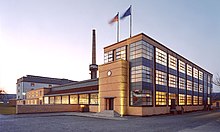Fagus-GreCon
| Fagus-GreCon Greten | |
|---|---|
| legal form | GmbH & Co. KG |
| founding | 1911 |
| Seat | Alfeld (leash) |
| Number of employees | approx. 600 worldwide (2017) |
| sales | 78 million euros (2017) |
| Website | https://www.fagus-grecon.com |
The Fagus-GreCon Greten GmbH & Co. KG is a global fire protection - Measurement - and shoe lasts -Unternehmen. It has its head office in Alfeld (Leine) and offices in Lüdenscheid and Nuremberg .
history
Carl Benscheidt founded the company in 1911 and commissioned Walter Gropius to build the Fagus factory as a shoe last factory. In 1925 the first Fagus shoe last lathe followed and the construction of woodworking machines began.
During the National Socialist era, Fagus was one of the German shoe companies that had their shoes tested by concentration camp inmates in the Sachsenhausen concentration camp . The prisoners in the so-called shoe runner detachment had to cover a 700-meter-long test route with different surfaces several times up to 40 kilometers. The endurance runs were de facto death marches , as the runners were shot when they collapsed due to fatigue .
In 1947 the Fagus factory in Alfeld was listed as a historical monument . In 2011 it was declared a World Heritage Site by UNESCO .
In 1970, Gerd and Ernst Greten, great-grandsons of Carl Benscheidt, founded Greten Consulting (GreCon) and in 1974 took over the management of Fagus-GreCon. This was followed by developments in the first basis weight measuring system and the first thickness measuring system, as well as in 1974 the first industrial spark extinguishing system . In 1987 the first scanner for automatic defect detection in solid wood was developed.
In 1998 the company entered into a joint venture with its competitor Dimter, a Weinig International AG company .
In 2000 Fagus-GreCon became an external project of the Expo 2000 Hanover. In 2002, the production of high-precision milling strips for fully automatic shoe production began. The entire building complex was restored between 1982 and 2002. In 2005, the first Dieffensor X-ray scanner was installed to detect foreign bodies in the chip fleece. In 2006, the company received the award Selected Location for Germany - Land of Ideas .
Web links
Individual evidence
- ^ Anne-Sophie Lang: Experiments in the concentration camp: blood in the shoe. November 13, 2014, accessed August 27, 2020 .
- ↑ Key building of modernity: The Fagus factory. In: NDR. June 24, 2016. Retrieved November 11, 2018 .

